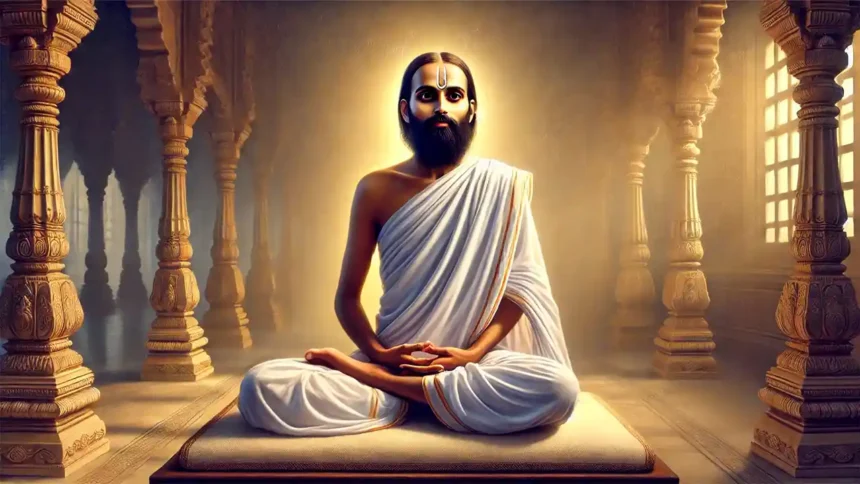The Mystic of Dakshineswar: How Ramakrishna Paramahamsa Redefined Spirituality
Ramakrishna Paramahamsa is one of the most revered spiritual figures in India. His life and teachings have inspired millions of people around the world. Born in 1836 in a small village called Kamarpukur in West Bengal, Ramakrishna’s journey from a simple village boy to a great spiritual master is nothing short of extraordinary. His teachings emphasized the unity of all religions and the importance of experiencing God directly.
Early Life and Childhood
Ramakrishna Paramahamsa, born as Gadadhar Chattopadhyay on February 18, 1836, in the quaint village of Kamarpukur, Bengal Presidency, India, emerged as a beacon of spirituality in the 19th century. His parents, Kshudiram Chattopadhyay and Chandramani Devi, were devout Brahmins known for their unwavering piety and virtue. Despite their modest means, they instilled in young Gadadhar a profound sense of devotion and righteousness.
Even as a child, he was known for his love of nature and his tendency to go into deep states of meditation. He was not very interested in formal education but was deeply drawn to spiritual practices and stories of gods and goddesses.
At the age of sixteen, Ramakrishna moved to Kolkata to assist his elder brother, who was a priest at the Dakshineswar Kali Temple. This temple would later become the center of his spiritual activities and the place where he would attain profound spiritual experiences.
Spiritual Awakening at Dakshineswar
The Dakshineswar Kali Temple became the turning point in Ramakrishna’s life. As a priest, he was responsible for taking care of the idol of Goddess Kali. However, he was not satisfied with just performing rituals. He wanted to experience the presence of the Goddess directly.
Ramakrishna’s longing for God became so intense that he would spend hours in front of the idol, crying and praying for a vision of the Divine Mother. His devotion was so deep that he often forgot to eat or sleep. People around him thought he was going mad, but in reality, he was undergoing a profound spiritual transformation.
One day, his prayers were answered. He had a vision of Goddess Kali as a living, breathing presence. This experience filled him with immense joy and peace. From that day on, Ramakrishna’s life was dedicated to seeking and experiencing God in various forms.
Experiments with Different Paths
What makes Ramakrishna unique is his openness to different spiritual paths. He did not limit himself to one religion or practice. Instead, he explored various paths to understand the nature of God.
- Hinduism: As a priest of the Kali Temple, Ramakrishna practiced intense devotion (bhakti) to Goddess Kali. He also followed the path of Advaita Vedanta, which teaches that the soul and God are one. Under the guidance of his guru, Totapuri, he experienced the state of Nirvikalpa Samadhi, where the mind merges with the universal consciousness.
- Islam: Ramakrishna practiced Islam under the guidance of a Sufi saint. He dressed like a Muslim, prayed in the Islamic way, and even stopped worshiping Hindu deities. After a few days, he had a vision of Prophet Muhammad and realized that Islam also leads to the same ultimate truth.
- Christianity: Similarly, Ramakrishna practiced Christianity and had a vision of Jesus Christ. He understood that Christianity, too, was a valid path to God.
Through these experiments, Ramakrishna concluded that all religions are different paths to the same ultimate truth. He famously said, “As many faiths, so many paths.”
Teachings of Ramakrishna
Ramakrishna’s teachings were simple yet profound. He did not write any books, but his disciples, especially Swami Vivekananda, recorded his conversations and teachings. Here are some of his key teachings:
- Unity of Religions: Ramakrishna believed that all religions lead to the same God. He compared religions to different rivers flowing into the same ocean.
- Importance of Direct Experience: He emphasized that intellectual knowledge of God is not enough. One must experience God directly through devotion, meditation, or selfless service.
- God is Within: Ramakrishna taught that God resides within every human being. To realize God, one must turn inward and purify the mind.
- Renunciation and Detachment: He advised his followers to detach themselves from material desires and focus on spiritual growth.
- Service to Humanity: Ramakrishna believed that serving others is a form of worship. He inspired his disciples to work for the welfare of humanity.
Relationship with Swami Vivekananda
One of the most significant aspects of Ramakrishna’s life was his relationship with Swami Vivekananda. Vivekananda, originally named Narendranath Dutta, was a young, skeptical student when he first met Ramakrishna. He challenged Ramakrishna with tough questions about God and religion.
Ramakrishna’s patience and wisdom eventually won over Vivekananda. He became one of Ramakrishna’s most devoted disciples and later played a crucial role in spreading his teachings worldwide. After Ramakrishna’s death, Vivekananda founded the Ramakrishna Mission, an organization dedicated to serving humanity and promoting spiritual values.
Final Days and Legacy
Ramakrishna’s health began to decline in his later years. He was diagnosed with throat cancer, but he continued to teach and inspire his disciples until the very end. He passed away on August 16, 1886, at the age of 50.
Ramakrishna’s legacy lives on through his teachings and the Ramakrishna Mission. His life is a testament to the power of faith, devotion, and the unity of all religions. He showed that it is possible to experience God directly and that spirituality is not limited to any one path.
Ramakrishna Paramahamsa Quotes
Ramakrishna’s words were filled with wisdom and simplicity. Here are some of his most famous quotes:
“The winds of grace are always blowing, but you must raise the sail.”
- This quote emphasizes the importance of effort and readiness to receive divine blessings.
“God is in all men, but all men are not in God; that is why we suffer.”
- Ramakrishna taught that suffering arises when we forget our divine nature.
“He is born in vain, who having attained the human birth, so difficult to get, does not attempt to realize God in this very life.”
- This quote highlights the importance of spiritual pursuit in human life.
“Do not be small-minded. Do not pray for gourds and pumpkins from God, when you should be asking for pure love and pure knowledge to dawn in every heart.”
- Ramakrishna encouraged people to seek higher spiritual goals rather than material gains.
“The truth is, you cannot believe in God until you believe in yourself.”
- This quote reflects his teaching that self-confidence and self-realization are key to spiritual growth.
“Many are the names of God and infinite the forms through which He may be approached.”
- This quote reflects his belief in the unity of all religions.
Ramakrishna Paramahamsa Books
Although Ramakrishna did not write any books himself, his teachings were recorded by his disciples. Here are some of the most important books based on his life and teachings:
- “The Gospel of Sri Ramakrishna”
- This is the most famous book about Ramakrishna’s life and teachings. It was written by Mahendranath Gupta, also known as “M,” who was a close disciple of Ramakrishna. The book is a detailed record of Ramakrishna’s conversations, parables, and spiritual experiences.
- “Teachings of Sri Ramakrishna”
- This book is a compilation of Ramakrishna’s teachings, organized by topic. It covers his views on God, devotion, meditation, and the unity of religions.
- “Sri Ramakrishna: The Great Master”
- Written by Swami Saradananda, a direct disciple of Ramakrishna, this book provides a comprehensive biography of Ramakrishna’s life and spiritual journey.
- “Ramakrishna: His Life and Sayings”
- This book, written by F. Max Müller, a renowned scholar, offers a Western perspective on Ramakrishna’s life and teachings.
- “Sayings of Sri Ramakrishna”
- This is a collection of Ramakrishna’s most profound and inspiring quotes, compiled for easy reading and reflection.
Ramakrishna Paramahamsa Stories
Ramakrishna often used simple stories and parables to explain deep spiritual truths. Here are a few of his most famous stories:
- The Story of the Milkmaid
- Ramakrishna once told the story of a milkmaid who was so devoted to Lord Krishna that she would talk to him while churning butter. One day, her husband scolded her for not focusing on her work. She replied, “I am churning butter for Krishna, and he is helping me.” Ramakrishna used this story to illustrate the power of devotion and seeing God in every action.
- The Story of the Frog in the Well
- Ramakrishna compared a narrow-minded person to a frog living in a well. The frog believed that the well was the entire world until one day, another frog from the ocean visited and told him about the vastness of the sea. Ramakrishna used this story to teach that one must expand their mind to understand the infinite nature of God.
- The Story of the Salt Doll
- Ramakrishna told the story of a salt doll that wanted to measure the depth of the ocean. As soon as it entered the water, it dissolved and became one with the ocean. He used this story to explain that the ego must dissolve to merge with God.
- The Story of the Two Friends
- Ramakrishna narrated the story of two friends who were walking through a forest. One was afraid of ghosts, while the other was fearless. The fearless friend carried a lamp, and whenever the other felt scared, he would say, “Look, there is light. There is nothing to fear.” Ramakrishna used this story to teach that faith in God is like a lamp that dispels the darkness of fear and ignorance.
FAQs About Ramakrishna Paramahamsa
1. Who was Ramakrishna Paramahamsa?
Ramakrishna Paramahamsa was a 19th-century Indian saint and mystic who emphasized the unity of all religions and the importance of direct experience of God.
2. What is Ramakrishna famous for?
He is famous for his teachings on the unity of religions and his ability to experience God through different spiritual paths, including Hinduism, Islam, and Christianity.
3. What is the Ramakrishna Mission?
The Ramakrishna Mission is an organization founded by Swami Vivekananda to promote Ramakrishna’s teachings and serve humanity through education, healthcare, and social work.
4. Did Ramakrishna believe in God?
Yes, Ramakrishna was a deeply spiritual person who believed in the existence of God and dedicated his life to experiencing God directly.
5. What is the significance of Dakshineswar in Ramakrishna’s life?
Dakshineswar is where Ramakrishna served as a priest and had his first profound spiritual experience of Goddess Kali. It became the center of his spiritual activities.
6. How did Ramakrishna influence Swami Vivekananda?
Ramakrishna’s teachings and spiritual experiences deeply influenced Swami Vivekananda, who later became his chief disciple and spread his message globally.
7. What is the main message of Ramakrishna’s teachings?
The main message is that all religions lead to the same God, and the ultimate goal of life is to realize God through devotion, meditation, or selfless service.









